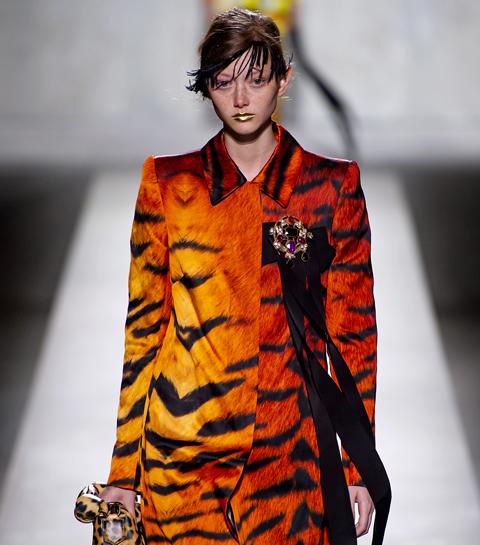Can fashion still do without collabs? - ELLE.be
They have always existed, since the Ancien Régime and associations of manufactures to create the most beautiful clothes of the court. In the modern period, between Dali and Saint Laurent, Picasso and Chanel. For several years, the machine has been racing. Collaborations, marketing eldorado or a way to combine talents?
Last April, there was the emblematic case of the hybridized Gucciaga collection presented by Alessandro Michele for Gucci, in homage to the strong imprint of Demna Gvasalia at Balenciaga (a "hacking" agreed between the two luxury houses belonging to the same band). Everywhere, collabs are flourishing, fueling the thirst for exclusivity and rarity among consumers galvanized by novelty. In the highly profitable sneaker business, tying together two already popular names usually ensures commercial success, with prices aligned with desirability.
Skills associations
For some brands, it's a way of exploring other areas of creation that aren't theirs, by getting help from well-established workshops. Everyone learns and optimizes their own know-how. These alliances of expertise have always existed. For Laurent Dombrowicz, stylist for numerous international magazines, journalist and consultant, “what is interesting and meaningful is the marriage of fashion against nature. When a luxury brand meets the technicality of a sports equipment manufacturer, like K-Way x Fendi. A simple idea is enough, and the collaboration becomes legitimate”. In this vein, for Y/Project, of which he is the artistic director, Glenn Martens regularly initiates associations with iconic brands recognized for their technicality, and breathes into them a sexy shift that creates surprise: Fila with a line of red carpet sportswear , Canada Goose with extrapolated outwear, Ugg and its unforgettable thigh-high boots dripping on the leg, Melissa Shoes and its baroque plastic shoes. Sure values at the start, which require a specific know-how, and enjoy, the time of a hybridization, a new originality. Everyone wins, especially lovers of niche pieces. But in its excesses, the overused formula of the collab intended to support sales can also result in superimposing logos, applying a TikTokable image. Visibility squared, profitability too.
Versatility or transdisciplinarity?
Thierry-Maxime Loriot, creative director, fashion expert, exhibition curator and writer, believes that, combined with social networks, collaborations represent an exponential marketing tool: "When Kate Moss does the Skims campaign for Kim Kardashian, the collaboration is studied on both sides to allow them to develop new markets on each side. Likewise, Virgil Abloh at Louis Vuitton probably signals a new commercial era for the brand in the United States. Influential people – beware, not influencers! – use collaborations to reach other audiences. It's a way of renewing oneself, the coolness of some supports the legend of others. In the case of the Dries Van Noten x Christian Lacroix collaboration, the Belgian designer had the intelligence, instead of doing Lacroix, to do “with” Lacroix. Some of these temporary associations can mark the history of fashion and the arts. Jean Paul Gaultier x Almodovar or Jean Paul Gaultier x Jeunet et Caro (Editor’s note, for “The city of lost children”), it is cultural exchanges that have influenced the success of these films, and the work of Gaultier himself. A culture that sometimes also feeds unofficially on fashion sources.
Lack of imagination or a sign of the times?
Laurent Dombrowicz validates the principle of collaborations between two brands when they highlight their identity and their respective know-how to meet and strengthen each other. “But at some point, it got out of hand, when it became a marketing system. If we talk about arty collaborations, most brands are really only paying royalties to reproduce works on a garment. It happened several times with Raf Simons. But this is not the essence of collaboration, to give oneself an “arty” conscience at a lower cost. On the other hand, other partnerships are really genuine. In particular those of Raf Simons precisely, with Sterling Ruby, who did not remain on the surface. But it's rarer in the fashion industry.

The second case where the principle of collaboration is misguided is when it is consanguineous. For example, Supreme x Louis Vuitton. They target the same public, there is no confrontation of universes, it brings nothing in terms of creativity, it's just a logo effect. The third type of collaboration, and this is the worst, is that initiated with celebrities. When a brand doesn't need a known name to generate interest, and the result brings nothing. There are celebrities that we pass between houses like kitchen cards, and we see these “top model x such and such a luxury brand” capsules flourish where the only thing that sells are names. The fashion that has so criticized the Cardin or Lacroix licenses is name dropping without legitimacy of creation. In an intelligently managed indirect partnership, he cites the works of art signed Helmut Lang x Saint Laurent, or the Longchamp x Jeremy Scott creations: “It was also very clever, mixing opposites, an old house and a cantor of pop . An opinion shared by Herbert Hofmann, creative director and head of purchasing at the business analysis media Highsnobiety, whose collaborations represent an important part of the activity. For him, "it is very interesting that brands inspire and support each other based on their know-how, especially when it comes to historic houses that cultivate a strong tradition, but whose greatest asset is not not necessarily story telling”. In this configuration, partnerships are an opportunity to strengthen both communication and transmission.
Special partners are looking for a special collaboration
Another responsibility, and not the least: that of properly securing the legal dimension of these associations. Corinne Champagner Katz, lawyer at the Paris Bar, specialist in intellectual property, recalls that “this is an exercise that is both interesting and restrictive. In law, we rather call it “partnerships”, for a shot or over time. The skills of one house act as a springboard for the skills of the other. Some creative industries very frequently contribute to the production of products for a brand, but we will never know, because it is done in B2B, at the level of raw materials. What makes a “collaboration” is when the names are known and communicated. This is the configuration that brings the most added value. Contracts must be concrete to record who brings what, to value these new intangible assets created by this partnership. The scope must be defined in terms of products, visibility and time. And of course, frame the financial distribution. In this respect, legal creativity has no limits either”.
But a collaboration is also a challenge of coordination, which has not escaped Yves Bensimon, head of the Bensimon collections: "You have to be aware that it's a lot of work, it monopolizes a whole team for a single project. . We are very much in demand, but in the end we accept very little, because it has to stick with our identity. For her spring-summer 2017 collection, Demna Gvasalia, then leader of the VETEMENTS collective, had initiated a collaboration with 18 popular brands (Eastpak, Reebok, Alpha Industries, Levis, Manolo Blahnik, Juicy Couture, Brioni, Schott, Canada Goose , Dr. Martens...) to integrate their universal culture into his subversive approach. The result was 18 mini-capsules intended for young people eager for references. Demna explained at the time that he had chosen more professional brands to manage specific products, because they had the capacity, the means and could meet deadlines. For them, who was then the best for the tailors? Brioni. For sexy shoes, pumps for women? Manolo Blahnik. For the leathers? Schott, who was in charge of making the perfectos. Each product had become the fruit of a different collaboration, and a box full. But not a relaxing parenthesis: they realized afterwards the magnitude of the logistical challenge, between Reebok which ensured its development in China, Manolo Blahnik in England, Juicy Couture in Los Angeles...
"In general, it's going well"
In the delta of many of these partnerships, Corinne Champagner Katz observes that in the majority of cases, “the houses like to work together, there is often mutual recognition”. Yves Bensimon also relativizes the systematization of the process: “Our brand has existed for a very long time, and we could do without collaborations. But in this case, they are always the fruit of beautiful encounters. The first, 15 years ago with Jean Paul Gaultier, was initiated for the anniversary of tennis. » Rudy Achache, CEO of the brand, adds: « For us, the work with Jean Paul Gaultier was reproduced over time, because it was a long-term approach. But sometimes you have to recognize when the chemistry isn't taking, so you stop the project if you can't find a story that makes enough sense. It has become a fashionable marketing tool for developing new international customers in particular, but I think the effect is rather temporary. »
Vices and virtues of collabs
They have been around since fashion started, but why is the phenomenon accelerating? According to Herbert Hofmann, the answer should be sought from marketing specialists, who are increasingly under the pressure of novelty. “Collaborations are a good way to multiply new product releases, when it is humanly impossible to have innovative ideas at this rate. In addition, collaborations allow consumers to express themselves with even more subtlety. In the case of Raf Simons x Prada, it was well seen to present this partnership in the form of “conversation” rather than “collaboration” because it is a case of co-creation, an invitation to review both the lines and the rules. of a house. The key is to stay organic. He recalls that some brands like Asics launched collaborations with emerging brands like GmbH very early on, and allowed them to grow. “It's brave, and it builds long-lasting business relationships. The collaborations signed by Highsnobiety are precisely without snobbery, they are inclusive. We travel, we live, we like to eat, we are fan of design, so there are processes that happen naturally, like the collaboration with Café de Flore, because during Fashion Week, we also want to chill on the terrace. Far from being hackneyed, collabs offer young brands a boost in popularity, and quite simply allow others to continue to exist.
READ ALSO
Kenzo x WWF: a wild collaboration for the preservation of tigers
Breaking news: H&M's next collaboration will be with Iris Apfel
Will digital clothing revolutionize fashion?
ELLE › Fashion › Can fashion still do without collabs?







